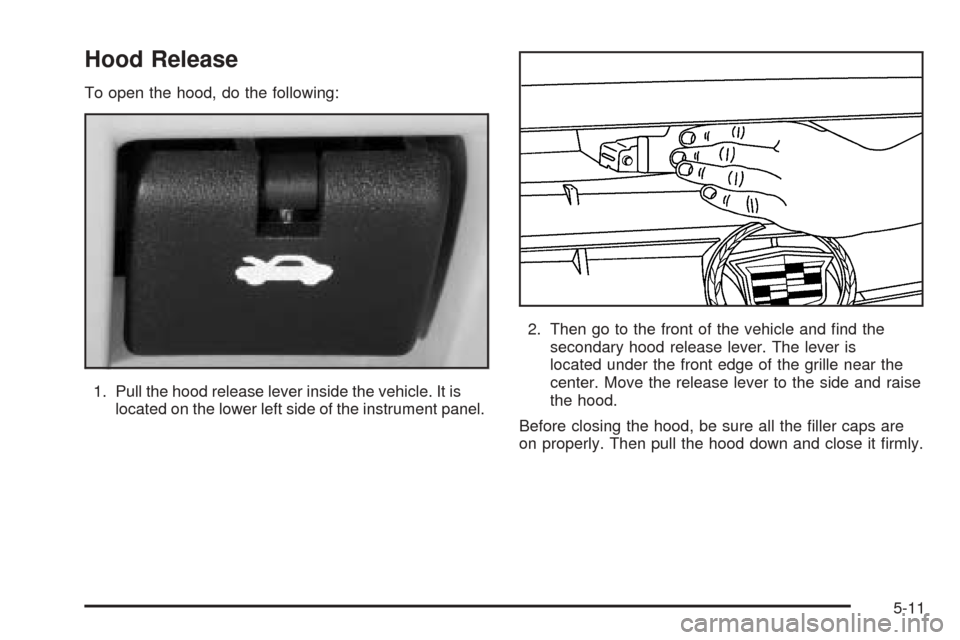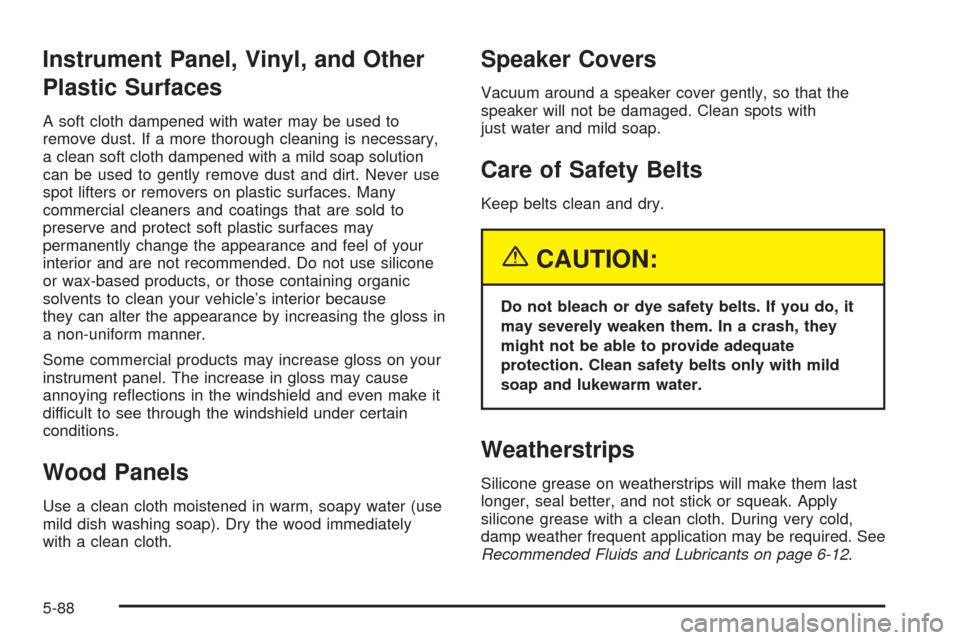2005 CADILLAC STS instrument panel
[x] Cancel search: instrument panelPage 298 of 446

Tire Inspection and Rotation...........................5-65
When It Is Time for New Tires.......................5-67
Buying New Tires.........................................5-68
Uniform Tire Quality Grading..........................5-70
Wheel Alignment and Tire Balance..................5-71
Wheel Replacement......................................5-71
Tire Chains..................................................5-73
If a Tire Goes Flat........................................5-74
Changing a Flat Tire.....................................5-74
Removing the Spare Tire and Tools................5-76
Removing the Flat Tire and Installing
the Spare Tire..........................................5-77
Storing a Flat or Spare Tire and Tools............5-83
Compact Spare Tire......................................5-84
Appearance Care............................................5-85
Cleaning the Inside of Your Vehicle.................5-85
Fabric/Carpet...............................................5-87
Leather.......................................................5-87
Instrument Panel, Vinyl, and Other
Plastic Surfaces........................................5-88
Wood Panels...............................................5-88
Speaker Covers............................................5-88
Care of Safety Belts......................................5-88
Weatherstrips...............................................5-88Washing Your Vehicle...................................5-89
Cleaning Exterior Lamps/Lenses.....................5-89
Finish Care..................................................5-89
Windshield and Wiper Blades.........................5-90
Aluminum or Chrome-Plated Wheels................5-91
Tires...........................................................5-91
Sheet Metal Damage.....................................5-92
Finish Damage.............................................5-92
Underbody Maintenance................................5-92
Chemical Paint Spotting.................................5-92
Vehicle Care/Appearance Materials..................5-93
Vehicle Identi�cation......................................5-94
Vehicle Identi�cation Number (VIN).................5-94
Service Parts Identi�cation Label.....................5-94
Electrical System............................................5-95
Add-On Electrical Equipment..........................5-95
Headlamp Wiring..........................................5-95
Windshield Wiper Fuses................................5-95
Power Windows and Other Power Options.......5-95
Fuses and Circuit Breakers............................5-95
Underhood Fuse Block..................................5-96
Rear Underseat Fuse Block...........................5-99
Capacities and Speci�cations........................5-106
Section 5 Service and Appearance Care
5-2
Page 307 of 446

Hood Release
To open the hood, do the following:
1. Pull the hood release lever inside the vehicle. It is
located on the lower left side of the instrument panel.2. Then go to the front of the vehicle and �nd the
secondary hood release lever. The lever is
located under the front edge of the grille near the
center. Move the release lever to the side and raise
the hood.
Before closing the hood, be sure all the �ller caps are
on properly. Then pull the hood down and close it �rmly.
5-11
Page 359 of 446

If a low tire pressure condition is detected, the TPM
system will display the CHECK TIRE PRESSURE
warning message on the Driver Information Center (DIC)
and, at the same time, illuminate the low tire pressure
warning symbol, on the instrument panel cluster.
When the tire pressure
monitoring system warning
light is lit, one or more
of your tires is signi�cantly
under-in�ated.
You should stop and check your tires as soon as
possible, and in�ate them to the proper pressure as
indicated on the vehicle’s tire information placard.
Driving on a signi�cantly under-in�ated tire causes the
tire to overheat and can lead to tire failure.
Under-in�ation also reduces fuel efficiency and tire tread
life, and may affect the vehicle’s handling and stopping
ability. Each tire, including the spare, should be
checked monthly when cold and set to the
recommended in�ation pressure as speci�ed in the
vehicle placard and owner’s manual.The Tire and Loading Information Label (your vehicle’s
tire information placard) shows the size of your vehicle’s
original tires and the recommended cold in�ation
pressure for your vehicle’s tire. SeeIn�ation - Tire
Pressure on page 5-60. For the location of the tire and
loading information label, seeLoading Your Vehicle on
page 4-30.
Your vehicle’s TPM system can alert you about a low
tire pressure condition but it does not replace normal tire
maintenance. SeeTire Inspection and Rotation on
page 5-65andTires on page 5-53.
Notice:Do not use a tire sealant if your vehicle is
equipped with Tire Pressure Monitors. The liquid
sealant can damage the tire pressure monitor
sensors.
5-63
Page 384 of 446

Instrument Panel, Vinyl, and Other
Plastic Surfaces
A soft cloth dampened with water may be used to
remove dust. If a more thorough cleaning is necessary,
a clean soft cloth dampened with a mild soap solution
can be used to gently remove dust and dirt. Never use
spot lifters or removers on plastic surfaces. Many
commercial cleaners and coatings that are sold to
preserve and protect soft plastic surfaces may
permanently change the appearance and feel of your
interior and are not recommended. Do not use silicone
or wax-based products, or those containing organic
solvents to clean your vehicle’s interior because
they can alter the appearance by increasing the gloss in
a non-uniform manner.
Some commercial products may increase gloss on your
instrument panel. The increase in gloss may cause
annoying re�ections in the windshield and even make it
difficult to see through the windshield under certain
conditions.
Wood Panels
Use a clean cloth moistened in warm, soapy water (use
mild dish washing soap). Dry the wood immediately
with a clean cloth.
Speaker Covers
Vacuum around a speaker cover gently, so that the
speaker will not be damaged. Clean spots with
just water and mild soap.
Care of Safety Belts
Keep belts clean and dry.
{CAUTION:
Do not bleach or dye safety belts. If you do, it
may severely weaken them. In a crash, they
might not be able to provide adequate
protection. Clean safety belts only with mild
soap and lukewarm water.
Weatherstrips
Silicone grease on weatherstrips will make them last
longer, seal better, and not stick or squeak. Apply
silicone grease with a clean cloth. During very cold,
damp weather frequent application may be required. See
Recommended Fluids and Lubricants on page 6-12.
5-88
Page 390 of 446

Vehicle Identi�cation
Vehicle Identi�cation Number (VIN)
This is the legal identi�er for your vehicle. It appears on
a plate in the front corner of the instrument panel, on
the driver’s side. You can see it if you look through the
windshield from outside your vehicle. The VIN also
appears on the Vehicle Certi�cation and Service Parts
labels and the certi�cates of title and registration.
Engine Identi�cation
The eighth character in your VIN is the engine code.
This code will help you identify your engine,
speci�cations and replacement parts.
Service Parts Identi�cation Label
You will �nd this label on your spare tire cover. It is very
helpful if you ever need to order parts. On this label,
you will �nd the following:
VIN
Model designation
Paint information
Production options and special equipment
Be sure that this label is not removed from the vehicle.
5-94
Page 393 of 446

The underhood fuse block is located in the front of the
engine compartment on the passenger’s side of the
vehicle. SeeEngine Compartment Overview on
page 5-12for more information on location, and removal
procedure for the front compartment underhood sights
shields.
To access the fuses, push in the tabs located on each
side of the fuse block cover. Then, lift the cover off.
Fuses Usage
BLOWER Blower Motor
R REAR Passenger’s Side Rear Fuse Block
I/P OUTLET Front Auxiliary Outlet
CCP Climate Control, Headlamp Leveling
PRE 02/CAM Oxygen Sensor, CAM Phasers
ENG W/H Engine W/H
R REAR Passenger’s Side Rear Fuse Block
WPR SW Wiper/Washer Switch
BODY W/H Body W/H
FOG LAMP Fog Lamps
OUTLET Rear Auxiliary Outlet
EVEN COILSEven Ignition Coils, Even Fuel
Injectors
L REAR Left Rear Fuse Block
WPR MOD Wiper Module
POST 02 Oxygen Sensor
Fuses Usage
COMP CLTCH Air Conditioner Compressor Clutch
STARTER Starter Solenoid
ABS Anti-Lock Brake Pump
L REAR Driver’s Side Rear Fuse Block
BODY W/H Body W/H
RAIN SSRRain Sensor, Headlamp Washer,
Tire Pressure Monitor
CCP Climate Control
SMT BM-OPT Smart Beam Relay (Option)
EXT LIGHTSLow Beam Relay, High Beam Relay,
Park Lamp Relay
VOLT CHECK Instrument Panel Module
ECM/TCMEngine Control Module,
Transmission Control Module,
Easy Key Module, Instrument
Panel Cluster
SPARE Spare
SPARE Spare
LT PARK Left Park Lamp, Left Taillamp
LIC DIMMINGLicense Plate, Instrument Panel
Dimming
IPM ALDLInstrument Panel Module Assembly
Line Data Link Connector
HUDHeads-Up Display, Column Lock
Module
5-97
Page 394 of 446

Fuses Usage
V8 ECM V8 ECM, Evap Solenoid
ABS Anti-Lock Brake Controller
STR RLY Starter Relay
WASH
NOZ/AQSHeated Washer Nozzles, Air Quality
Sensor™
ODD COILSOdd Ignition Coils, Odd Fuel
Injectors
TCM IPCTransmission, Instrument Panel,
Engine Control
SPARE Spare
MAF Mass Air Flow Sensor
HIGH FAN Cooling Fan - High Speed
LOW FAN Cooling Fan - Low Speed
RT PARK Right Park Lamp, Right Taillamp
HORN Horn
LT HI BEAM Left Headlamp High Beam
LT LOW BEAM Left Headlamp Low Beam
RT LOW BEAM Right Headlamp Low Beam
RT HI BEAM Right Headlamp High Beam
HFV6 ECMHigh Feature V6 Engine Control
ModuleRelays Usage
HDLP WASH
RELAY
JUMPER -OPTHeadlamp Washer
STARTER
RELAY MINIStarter
SPARE Spare
FOG LAMP
RELAY MICROFog Lamps
CMP CLU
RELAY MICROA/C Compressor Clutch
BLOWER
RELAY MINIFront Blower Motor
POWERTRAIN
RELAY MICROEngine Controls
RUN/CRANK
RELAY MICROIgnition 1
LOW SPEED
FAN RELAY
MINICooling Fan Low Speed
ACCESSORY
RELAY MINIIgnition 3
PARK LAMP
RELAY MICROParking Lamps
5-98
Page 422 of 446

Customer Assistance and
Information
Customer Satisfaction Procedure
Your satisfaction and goodwill are important to
your dealer and to Cadillac. Normally, any concerns
with the sales transaction or the operation of your
vehicle will be resolved by your dealer’s sales or service
departments. Sometimes, however, despite the best
intentions of all concerned, misunderstandings can
occur. If your concern has not been resolved to your
satisfaction, the following steps should be taken:
STEP ONE:Discuss your concern with a member of
dealership management. Normally, concerns can
be quickly resolved at that level. If the matter has
already been reviewed with the sales, service or parts
manager, contact the owner of the dealership or
the general manager.
STEP TWO:If after contacting a member of dealership
management, it appears your concern cannot be
resolved by the dealership without further help, contact
the Cadillac Customer Assistance Center, 24 hours
a day, by calling 1-800-458-8006. In Canada, contact
the Canadian Cadillac Customer Communication Centre
by calling 1-888-446-2000.We encourage you to call the toll-free number in order
to give your inquiry prompt attention. Please have
the following information available to give the Customer
Assistance Representative:
Vehicle Identi�cation Number (VIN). This is
available from the vehicle registration or title, or the
plate at the top left of the instrument panel and
visible through the windshield.
Dealership name and location.
Vehicle delivery date and present mileage.
When contacting Cadillac, please remember that your
concern will likely be resolved at a dealer’s facility. That
is why we suggest you follow Step One �rst if you
have a concern.
STEP THREE:Both General Motors and your dealer
are committed to making sure you are completely
satis�ed with your new vehicle. However, if you continue
to remain unsatis�ed after following the procedure
outlined in Steps One and Two, you should �le with the
BBB Auto Line Program to enforce any additional
rights you may have. Canadian owners refer to your
Warranty and Owner Assistance Information booklet for
information on the Canadian Motor Vehicle Arbitration
Plan (CAMVAP).
7-2